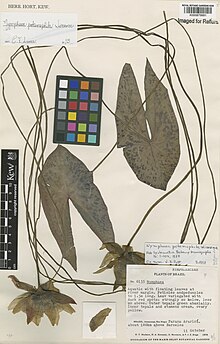| Nymphaea potamophila | |
|---|---|

| |
| Preserved herbarium specimen of Nymphaea potamophila Wiersema in the collection of the Royal Botanic Gardens, Kew | |
| Scientific classification | |
| Kingdom: | Plantae |
| Clade: | Tracheophytes |
| Clade: | Angiosperms |
| Order: | Nymphaeales |
| Family: | Nymphaeaceae |
| Genus: | Nymphaea |
| Subgenus: | Nymphaea subg. Hydrocallis |
| Species: | N. potamophila |
| Binomial name | |
| Nymphaea potamophila Wiersema | |

| |
| It is native to Venezuela and northern Brazil | |
Nymphaea potamophila is a species of waterlily native to the region spanning from Venezuela to northern Brazil. Additionally, it has been reported to occur in Colombia.
Description
Vegetative characteristics
Nymphaea potamophila is an aquatic herb. The elliptic-sagittate, papery leaf blades of floating leaves are up to 20 cm long and 10 cm wide. The leaf margin is entire and flat. The adaxial surface is coloured in green with overlaying patterns of red variegation. The abaxial surface has a greenish base colour accompanied by dark red variegation, but also exhibits patterns of branched, rusty-brown striations. The leaf structure is compact and the leaves are very thin (145.50 μm). This gives the leaves cold tolerance. The glabrous, 3 mm wide petioles are very long and can exceed 4 m in length.
Generative characteristics
The nocturnal floating flowers are connected to glabrous, 4 mm wide peduncles, which can exceed 4 m in length.
Cytology
The chloroplast genome size is 159,232 bp. The chromosome count is unknown.
Reproduction
Vegetative reproduction
Proliferating pseudanthia are not formed in this species.
Generative reproduction
High levels of both pollen viability and seed production are evident in Nymphaea potamophila. Sexual reproduction plays a significant role in this species.
Habitat
It can be found in the aquatic habitats of the Amazon Rainforest, where it can grow along river margins in up to 4-5 m deep water.
Taxonomy
Type specimen
The type specimen was collected in Brazil by a team of scientists consisting of J. Ramos, C.D. Mota, L.A. Maia, and E. Soares on the 28th of June 1979.
Placement within Nymphaea
It is placed in Nymphaea subg. Hydrocallis.
Conservation
The conservation status of this species in Brazil has not yet been evaluated.
References
- ^ "Nymphaea potamophila Wiersema". Plants of the World Online. Royal Botanic Gardens, Kew. Retrieved 8 November 2023.
- Atuesta-Ibargüen, D. J. (2019). Composición florística y formas de vida de las macrófitas acuáticas de la serranía de La Lindosa (Guaviare), Guayana colombiana - Floristic composition and life forms of aquatic macrophytes of serrania La Lindosa (Guaviare), Colombian Guiana. Caldasia, 41(2), 301–312. https://www.jstor.org/stable/26680473
- GBIF, Global Biodiversity Information Facility. (n.d.). Nymphaea potamophila Wiersema. Retrieved November 8, 2023, from https://www.gbif.org/species/3697289
- ^ Wiersema, J. H. (1984). "A new species of Nymphaea (Nymphaeaceae) from the Amazon Basin." SIDA, Contributions to Botany, 195-198.
- ^ Jardim Botânico do Rio de Janeiro. (n.d.). Nymphaea potamophila Wiersema. Flora E Funga Do Brasil. Retrieved November 8, 2023, from https://floradobrasil.jbrj.gov.br/consulta/ficha.html?idDadosListaBrasil=86095
- Yang, K. (2022). "Leaf Anatomic Structure and Cold Tolerance Evaluation of 6 Nymphaea Species." Plant Gene and Trait, 13.
- ^ Wiersema, J. H. (1987). A monograph of Nymphaea subgenus Hydrocallis (Nymphaeaceae). Systematic Botany Monographs, 1-112.
- ^ Sun, C., Chen, F., Teng, N., Xu, Y., & Dai, Z. (2021). "Comparative analysis of the complete chloroplast genome of seven Nymphaea species." Aquatic Botany, 170, 103353.
- Nymphaea potamophila | International Plant Names Index. (n.d.). Retrieved November 9, 2023, from https://www.ipni.org/n/281440-2
| Taxon identifiers | |
|---|---|
| Nymphaea potamophila | |